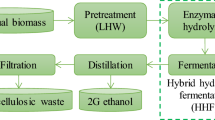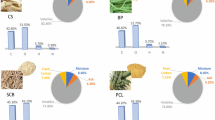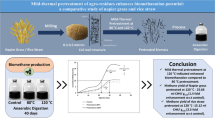Abstract
Lignocellulosic wastes from Amazonian crops are promising for the production of biochar. However, there are scientific gaps concerning the thermodegradation mechanisms of widely diverse biomass. This research explored the relationships between the chemical compounds and the pyrolysis behavior of the açai seed, cocoa pod husk, coconut husk, palm empty fruit bunch, and maize cob by thermogravimetric analysis. The cocoa pod husk and palm empty fruit bunch showed the lowest temperatures of initial degradation (≤ 230 °C) because of the highest proportions of total extractives (≥ 17% dry basis) and ashes (≥ 5.7% dry basis) combined with the lowest contents of holocellulose (≤ 56% dry basis). Biomasses with higher extractives contents showed pronounced mass losses at temperatures ≤ 300 °C. The maize cob, with more holocellulose (68% dry basis), revealed a high maximum rate of thermal degradation of 7.9% min−1 and mass loss between 200 and 400 °C of 65.6% wet basis. The high level of acetone-soluble extractives raised the temperature necessary for the initial thermal degradation of açai seed. The coconut husk, açai seed, and cocoa pod husk were the most suitable wastes for the production of biochar based on the average mass yields (≥ 41% wet basis) at the pyrolysis final temperature of 400 °C.
Graphic abstract








Similar content being viewed by others
Availability of data and materials
The datasets supporting the conclusions of this article are included in the article. Besides, the datasets used and/or analyzed during the current study are available from the corresponding author on reasonable request.
References
Ahmad MS, Mehmood MA, Al Ayed OS, Ye G, Luo H, Ibrahim M, Rashid U, Nehdi IA, Qadir G (2017a) Kinetic analyses and pyrolytic behavior of Para grass (Urochloa mutica) for its bioenergy potential. Bioresour Technol 224:708–713. https://doi.org/10.1016/j.biortech.2016.10.090
Ahmad MS, Mehmood MA, Taqvi STH, Elkamel A, Liu C-G, Xu J, Rahimuddin SA, Gull M (2017b) Pyrolysis, kinetics analysis, thermodynamics parameters and reaction mechanism of Typha latifolia to evaluate its bioenergy potential. Bioresour Technol 245:491–501. https://doi.org/10.1016/j.biortech.2017.08.162
Alves JLF, Silva JCG, Silva Filho VF, Alves RF, Galdino WVA, Andersen SLF, Sena RF (2019) Determination of the bioenergy potential of brazilian pine-fruit shell via pyrolysis kinetics, thermodynamic study, and evolved gas analysis. BioEnergy Res 12:168–183. https://doi.org/10.1007/s12155-019-9964-1
Andrade CR, Dias Junior AF, Brito JO, Protásio TP, Trugilho PF, Melo ICNA (2017) Waste wood of urban origin for energy use. Rev Árvore 41:1–8. https://doi.org/10.1590/1806-90882017000200008
ASTM—American Society for Testing Materials (2007) D1762–84: standard test method for chemical analysis of wood charcoal. ASTM International, Philadelphia
Banzatto DA, Kronka SN (2006) Experimentação Agrícola. FUNEP, Jaboticabal (In Portuguese)
Browning BL (1963) The chemistry of wood. Interscience Publisher, New York
Chang K-H, Lou K-R, Ko C-H (2019) Potential of bioenergy production from biomass wastes of rice paddies and forest sectors in Taiwan. J Clean Prod 206:460–476. https://doi.org/10.1016/j.jclepro.2018.09.048
Chen Y, Fang Y, Yang H, Xin S, Zhang X, Wang X, Chen H (2019) Effect of volatiles interaction during pyrolysis of cellulose, hemicellulose, and lignin at different temperatures. Fuel 248:1–7. https://doi.org/10.1016/j.fuel.2019.03.070
Costa JS, Silva MG, Scatolino MV, Lima MDR, Assis MR, Bufalino L, Numazawa S, Trugilho PF, Protásio TP (2020) Relating features and combustion behavior of biomasses from the Amazonian agroforestry chain. Biomass Convers Biorefinery. https://doi.org/10.1007/s13399-020-01121-1
Cui X, Hao H, Zhang C, He Z, Yang X (2016) Capacity and mechanisms of ammonium and cadmium sorption on different wetland-plant derived biochars. Sci Total Environ 539:566–575. https://doi.org/10.1016/j.scitotenv.2015.09.022
Dias Júnior AF, Andrade CR, Protásio TP, Brito JO, Trugilho PF, Oliveira MP, Dambroz GBV (2019) Thermal profile of wood species from the Brazilian Semi-arid region submitted to pyrolysis. Cerne 25:44–53. https://doi.org/10.1590/01047760201925012602
Efika CE, Onwudili JA, Williams PT (2018) Influence of heating rates on the products of high-temperature pyrolysis of waste wood pellets and biomass model compounds. Waste Manag 76:497–506. https://doi.org/10.1016/j.wasman.2018.03.021
Fermanelli CS, Córdoba A, Pierella LB, Saux C (2020) Pyrolysis and copyrolysis of three lignocellulosic biomass residues from the agro-food industry: a comparative study. Waste Manag 102:362–370. https://doi.org/10.1016/j.wasman.2019.10.057
Foong SY, Liew RK, Yang Y, Cheng YW, Yek PNY, Mahari WAW, Lee XY, Han CS, Vo DVN, Le QV, Aghbashlo M, Tabatabaei M, Sonne C, Peng W, Lam SS (2020) Valorization of biomass waste to engineered activated biochar by microwave pyrolysis: progress, challenges, and future directions. Chem Eng J 389:124401. https://doi.org/10.1016/j.cej.2020.124401
FAO—Food and Agriculture Organization of the United Nations (2020) Forestry Production and Trade. http://www.fao.org/faostat/en/#data/FO/visualize
Gani A, Naruse I (2007) Effect of cellulose and lignin content on pyrolysis and combustion characteristics for several types of biomass. Renew Energy 32:649–661. https://doi.org/10.1016/j.renene.2006.02.017
Goldschimid O (1971) Ultraviolet spectra. In: Sarkanen KV, Ludwig CH (eds) Lignins: occurrence, formation, structure and reactions. Wiley, New York, pp 241–298
Gomide JL, Demuner BJ (1986) Determination of lignin in woody material: modified Klason method. O Pap 47:36–38
Guan Y, Liu C, Peng Q, Zaman F, Zhang H, Jin Z, Wang A, Wang W, Huang Y (2019) Pyrolysis kinetics behavior of solid leather wastes. Waste Manag 100:122–127. https://doi.org/10.1016/j.wasman.2019.09.005
Hu M, Chen Z, Wang S, Guo D, Ma C, Zhou Y, Chen J, Laghari M, Fazal S, Xiao B, Zhang B, Ma S (2016) Thermogravimetric kinetics of lignocellulosic biomass slow pyrolysis using distributed activation energy model, Fraser-Suzuki deconvolution, and iso-conversional method. Energy Convers Manag 118:1–11. https://doi.org/10.1016/j.enconman.2016.03.058
IBGE—Instituto Brasileiro de Geografia e Estatística (2020) Sistema IBGE de Recuperação Automática: SIDRA. https://sidra.ibge.gov.br/home/pms/brasil. Accessed 6 Feb 2020
Iqbal MW, Kang Y, Jeon HW (2020) Zero waste strategy for green supply chain management with minimization of energy consumption. J Clean Prod 245:118827. https://doi.org/10.1016/j.jclepro.2019.118827
Kaczor Z, Buliński Z, Werle S (2020) Modelling approaches to waste biomass pyrolysis: a review. Renew Energy 159:427–443. https://doi.org/10.1016/j.renene.2020.05.110
Kanca A (2020) Investigation on pyrolysis and combustion characteristics of low quality lignite, cotton waste, and their blends by TGA-FTIR. Fuel 263:116517. https://doi.org/10.1016/j.fuel.2019.116517
Kennedy JF, Phillips GO, Williams PA (1987) Wood and cellulosics: industrial utilization, biotechnology, structure and properties. Ellis Horwood, Chichester
Klinghoffer NB, Castaldi MJ, Nzihou A (2015) Influence of char composition and inorganics on catalytic activity of char from biomass gasification. Fuel 157:37–47. https://doi.org/10.1016/j.fuel.2015.04.036
Kluska J, Ochnio M, Kardaś D, Heda Ł (2019) The influence of temperature on the physicochemical properties of products of pyrolysis of leather-tannery waste. Waste Manag 88:248–256. https://doi.org/10.1016/j.wasman.2019.03.046
Kluska J, Ochnio M, Kardaś D (2020) Carbonization of corncobs for the preparation of barbecue charcoal and combustion characteristics of corncob char. Waste Manag 105:560–565. https://doi.org/10.1016/j.wasman.2020.02.036
Laougé ZB, Merdun H (2020) Kinetic analysis of Pearl Millet (Penissetum glaucum (L.) R. Br.) under pyrolysis and combustion to investigate its bioenergy potential. Fuel 267:117172. https://doi.org/10.1016/j.fuel.2020.117172
Mak TMW, Xiong X, Tsang DCW, Yu IKM, Poon CS (2020) Sustainable food waste management towards circular bioeconomy: policy review, limitations and opportunities. Bioresour Technol 297:122497. https://doi.org/10.1016/j.biortech.2019.122497
Martinez CLM, Rocha EPA, Carneiro ACO, Gomes FJB, Bathala LAR, Vakkilainen E, Cardoso M (2019) Characterization of residual biomasses from the coffee production chain and assessment the potential for energy purposes. Biomass Bioenerg 120:68–76. https://doi.org/10.1016/j.biombioe.2018.11.003
Mészáros E, Jakab E, Várhegyi G (2007) TG/MS, Py-GC/MS and THM-GC/MS study of the composition and thermal behavior of extractive components of Robinia pseudoacacia. J Anal Appl Pyrolysis 79:61–70. https://doi.org/10.1016/j.jaap.2006.12.007
Mishra RK, Mohanty K (2018) Characterization of non-edible lignocellulosic biomass in terms of their candidacy towards alternative renewable fuels. Biomass Convers Biorefinery 8:799–812. https://doi.org/10.1007/s13399-018-0332-8
Moya R, Rodríguez-Zúñiga A, Puente-Urbina A (2017) Thermogravimetric and devolatilisation analysis for five plantation species: effect of extractives, ash compositions, chemical compositions and energy parameters. Thermochim Acta 647:36–46. https://doi.org/10.1016/j.tca.2016.11.014
Müsellim E, Tahir MH, Ahmad MS, Ceylan S (2018) Thermokinetic and TG/DSC-FTIR study of pea waste biomass pyrolysis. Appl Therm Eng 137:54–61. https://doi.org/10.1016/j.applthermaleng.2018.03.050
Musule R, Acuña E, Osorio LSR-H, Domínguez Z, Bárcenas-Pazos GM, Pineda-López MR, Mendonça RT, González ME, Sánchez-Velásquez LR (2018) Growing up at different altitudes: changes in energy content of the Abies religiosa wood. BioEnergy Res 11:209–218. https://doi.org/10.1007/s12155-017-9889-5
Parascanu MM, Sánchez P, Soreanu G, Valverde JL, Sanchez-Silva L (2019) Mexican biomasses valorization through pyrolysis process: environmental and costs analysis. Waste Manag 95:171–181. https://doi.org/10.1016/j.wasman.2019.06.007
Poletto M (2016) Effect of extractive content on the thermal stability of two wood species from Brazil. Maderas Cienc y Tecnol 18:435–442. https://doi.org/10.4067/S0718-221X2016005000039
Poletto M (2017) Assessment of the thermal behavior of lignins from softwood and hardwood species. Maderas Cienc y Tecnol 19:63–74. https://doi.org/10.4067/S0718-221X2017005000006
Protásio TP, Scatolino MV, Araújo ACC, Oliveira AFCF, Figueiredo ICR, Assis MR, Trugilho PF (2019) Assessing proximate composition, extractive concentration, and lignin quality to determine appropriate parameters for selection of superior Eucalyptus firewood. BioEnergy Res 12:626–641. https://doi.org/10.1007/s12155-019-10004-x
Protásio TP, Scatolino MV, Lima MDR, Araújo ACC, Figueiredo ICR, Bufalino L, Hein PRG, Trugilho PF (2020) Insights in quantitative indexes for better grouping and classification of Eucalyptus clones used in combustion and energy cogeneration processes in Brazil. Biomass Bioenerg 143:105835. https://doi.org/10.1016/j.biombioe.2020.105835
R Core Team (2019) R: a language and environment for statistical computing. R Foundation for Statistical Computing, Viena
Santana DAR, Scatolino MV, Lima MDR, Barros Junior UO, Garcia DP, Andrade CR, Carneiro ACO, Trugilho PF, Protásio TP (2020) Pelletizing of lignocellulosic wastes as an environmentally friendly solution for the energy supply: insights on the properties of pellets from Brazilian biomasses. Environ Sci Pollut Res. https://doi.org/10.1007/s11356-020-11401-y
Sato MK, Lima HV, Costa AN, Rodrigues S, Pedroso AJS, Maia CMBF (2019) Biochar from Acai agroindustry waste: study of pyrolysis conditions. Waste Manag 96:158–167. https://doi.org/10.1016/j.wasman.2019.07.022
Sato MK, Lima HV, Costa AN, Rodrigues S, Mooney SJ, Clarkee M, Pedroso AJS, Maia CMBF (2020) Biochar as a sustainable alternative to açaí waste disposal in Amazon, Brazil. Process Saf Environ Prot 139:36–46. https://doi.org/10.1016/j.psep.2020.04.001
Scatolino MV, Neto LFC, Protásio TP, Carneiro ACO, Andrade CR, Guimarães Júnior JB, Mendes LM (2018a) Options for generation of sustainable energy: production of pellets based on combinations between lignocellulosic biomasses. Waste Biomass Valorization 9:479–489. https://doi.org/10.1007/s12649-017-0010-2
Scatolino MV, Fonseca CS, Gomes MS, Rompa VD, Martins MA, Tonoli GHD, Mendes LM (2018b) How the surface wettability and modulus of elasticity of the Amazonian paricá nanofibrils films are affected by the chemical changes of the natural fibers. Eur J Wood Wood Prod 76:1581–1594. https://doi.org/10.1007/s00107-018-1343-7
Shen J, Igathinathane C, Yu M, Pothula AK (2015) Biomass pyrolysis and combustion integral and differential reaction heats with temperatures using thermogravimetric analysis/differential scanning calorimetry. Bioresour Technol 185:89–98. https://doi.org/10.1016/j.biortech.2015.02.079
Sher F, Iqbal SZ, Liu H, Imran M, Snape CE (2020) Thermal and kinetic analysis of diverse biomass fuels under different reaction environment: a way forward to renewable energy sources. Energy Convers Manag 203:112266. https://doi.org/10.1016/j.enconman.2019.112266
Silva-Martínez RD, Sanches-Pereira A, Ortiz W, Galindo MFG, Coelho ST (2020) The state-of-the-art of organic waste to energy in Latin America and the Caribbean: challenges and opportunities. Renew Energy 156:509–525. https://doi.org/10.1016/j.renene.2020.04.056
Su C-C, Ma J-F, Chen Y-P (2019) Biochar can improve the soil quality of new creation farmland on the Loess Plateau. Environ Sci Pollut Res 26:2662–2670. https://doi.org/10.1007/s11356-018-3550-5
Tahir MH, Zhao Z, Ren J, Rasool T, Naqvi SR (2019) Thermo-kinetics and gaseous product analysis of banana peel pyrolysis for its bioenergy potential. Biomass Bioenerg 122:193–201. https://doi.org/10.1016/j.biombioe.2019.01.009
TAPPI—Technical Association of the Pulp and Paper Industry (1999b) T 207 cm-99: water solubility of wood and pulp. TAPPI Press, USA
TAPPI—Technical Association of the Pulp and Paper Industry (1999a) T 280 pm-99: acetone extractives of wood and pulp. TAPPI, Atlanta
Toscano G, Duca D, Pedretti EF, Pizzi A, Rossini G, Mengarelli C, Mancini M (2016) Investigation of woodchip quality: relationship between the most important chemical and physical parameters. Energy 106:38–44. https://doi.org/10.1016/j.energy.2016.03.037
Trabelsi ABH, Zaafouri K, Friaa A, Abidi S, Naoui S, Jamaaoui F (2020) Municipal sewage sludge energetic conversion as a tool for environmental sustainability: production of innovative biofuels and biochar. Environ Sci Pollut Res. https://doi.org/10.1007/s11356-020-11400-z
Varma AK, Thakur LS, Shankar R, Mondal P (2019) Pyrolysis of wood sawdust: effects of process parameters on products yield and characterization of products. Waste Manag 89:224–235. https://doi.org/10.1016/j.wasman.2019.04.016
Wang S, Dai G, Yang H, Luo Z (2017) Lignocellulosic biomass pyrolysis mechanism: a state-of-the-art review. Prog Energy Combust Sci 62:33–86. https://doi.org/10.1016/j.pecs.2017.05.004
Wienchol P, Szlęk A, Ditaranto M (2020) Waste-to-energy technology integrated with carbon capture: challenges and opportunities. Energy 198:117352. https://doi.org/10.1016/j.energy.2020.117352
Xi J, Li H, Xi J, Tan S, Zheng J, Tan Z (2020) Effect of returning biochar from different pyrolysis temperatures and atmospheres on the growth of leaf-used lettuce. Environ Sci Pollut Res 27:35802–35813. https://doi.org/10.1007/s11356-020-09840-8
Xu Z, Elomri A, Pokharel S, Zhang Q, Ming XG, Liu W (2017) Global reverse supply chain design for solid waste recycling under uncertainties and carbon emission constraint. Waste Manag 64:358–370. https://doi.org/10.1016/j.wasman.2017.02.024
Yang H, Yan R, Chen H, Lee DH, Zheng C (2007) Characteristics of hemicellulose, cellulose and lignin pyrolysis. Fuel 86:1781–1788. https://doi.org/10.1016/j.fuel.2006.12.013
Yang G, Wu L, Xian Q, Shen F, Wu J, Zhang Y (2016) Removal of congo red and methylene blue from aqueous solutions by vermicompost-derived biochars. PLoS ONE 11:e0154562. https://doi.org/10.1371/journal.pone.0154562
Yuan R, Yu S, Shen Y (2019) Pyrolysis and combustion kinetics of lignocellulosic biomass pellets with calcium-rich wastes from agro-forestry residues. Waste Manag 87:86–96. https://doi.org/10.1016/j.wasman.2019.02.009
Zaini IN, López CG, Pretz T, Yang W, Jönsson PG (2019) Characterization of pyrolysis products of high-ash excavated-waste and its char gasification reactivity and kinetics under a steam atmosphere. Waste Manag 97:149–163. https://doi.org/10.1016/j.wasman.2019.08.001
Zhou B, Liu W, Gong Y, Dong L, Deng Y (2019) High-performance pseudocapacitors from kraft lignin modified active carbon. Electrochim Acta 320:134640. https://doi.org/10.1016/j.electacta.2019.134640
Acknowledgements
The authors express their sincere gratefulness to the Multi-User Biomaterials Laboratory of the Federal University of Lavras (Brazil) for the assistance that was indispensable for carrying out this research.
Funding
National Council for Scientific and Technological Development (CNPq—grant number 306793/2019-9) and Coordination for the Improvement of Higher Education Personnel (CAPES—Finance Code 001).
Author information
Authors and Affiliations
Contributions
TPP contributed with the writing of the initial version, review, and data analysis. JSC and MRA contributed to the data collection. LB and MVS was a major contributor in writing the manuscript, specifically writing the initial version and review. MDRL, AFDJ and MGS were major contributors with the review and editing of the manuscript. PFT contributed with supervision, conceptualization, funding acquisition, and project administration. All authors read and approved the final manuscript.
Corresponding author
Ethics declarations
Conflict of interest
The authors declare that they have no conflict of interest.
Ethics approval
This article does not contain any studies with human participants or animals performed by any of the authors.
Additional information
Editorial responsibility: Samareh Mirkia.
Rights and permissions
About this article
Cite this article
de Paula Protásio, T., da Costa, J.S., Scatolino, M.V. et al. Revealing the influence of chemical compounds on the pyrolysis of lignocellulosic wastes from the Amazonian production chains. Int. J. Environ. Sci. Technol. 19, 4491–4508 (2022). https://doi.org/10.1007/s13762-021-03416-w
Received:
Revised:
Accepted:
Published:
Issue Date:
DOI: https://doi.org/10.1007/s13762-021-03416-w




